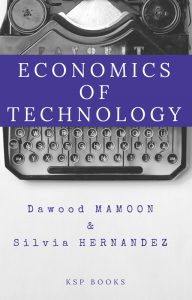Synopsis
In 2009, Brian Arthur claimed that one of the most important problems to understand regarding technology is to explain how it evolves (p.15ff). In fact, the evolution of technology plays an important role in the economic and social change of human societies. Technological evolution as a main process of technical change has been compared to biological evolution by many scholars. The similarities between biological and technological evolution have generated a considerable literature. Wagner & Rosenargued that biological thinking has reduced the distance between life sciences and social sciences. Basalla, suggested that the history of technology can profitably be seen as analogous to biological evolution. Technological evolution, alongside biological evolution, displays radiations, stasis, extinctions, and novelty. In general, patterns of technological innovation emerge and evolve with technological paradigms and trajectories in specific economic, institutional and social environments. Hosler argues that the development of technology is, at least to some extent, influenced by “technical choices”, which express social and political factors, and “technical requirements”, imposed by material properties. Arthur & Polak claim that: “Technology … evolves by constructing new devices and methods from ones that previously exist, and in turn offering these as possible components—building blocks—for the construction of further new devices and elements”. In particular, Arthur, argues that the evolution of technology is due to combinatorial evolution: “Technologies somehow must come into being as fresh combinations of what already exists.” This combination of components and assemblies is organized into systems or modules to some human purpose and has a hierarchical and recursive structure. Other scholars suggest that technological evolution is driven by solving consequential problems during the engineering process and by supporting leadership of distinct purposeful organizations —for instance firms— to achieve the prospect of a (temporary) profit monopoly and/or competitive advantage.
In this context, the main goal of this book is to explain some characteristics of the evolution of technology in society. In particular, this book focuses on new studies that can clarify how new technology evolve, how to measure new directions of technological trajectories, how to classify the evolution of technology, which are the main sources of the evolution of innovation in socioeconomic systems to suggest general properties that can explain technical change in industrial completion.
This book is designed for students, undergraduate, graduate or managers in business and public administration that wish to understand critical aspects of the evolution of technology and that wish to expand their knowledge on these research fields.
I have attempted to apply simple theories and approaches for explaining theoretical and empirical patterns of technological evolution in socioeconomic systems. Moreover, the studies here are integrated with examples and actual applications in economic and social settings that can help policymakers and manager to design best practices for achieving and sustaining competitive advantage. In order to attain a reasonable depth, this book concentrates on selected topics of particular relevance to the evolution of technology, and which meet the needs of the intended audience.
The book is divided in six interrelated chapters.
- First of all, the chapter 1 of the book explains the concept and characteristics of revolution and evolution to underpin the theoretical frameworks, techniques and sources of the evolution of technologies explained later.
- The chapter 2 of this book proposes a general theorem that explains how technology evolve over time and space, suggesting main theoretical predictions.
- The chapter 3 contains a technometrics to measure and assess technological evolution, as well as to classify technological pathways considering the interaction between technologies.
- Chapter 4 of the book concentrates on development of product innovation, suggesting a hedonic price method to analyze critical technical characteristics and technological trajectories that support the evolution of smartphone technology, a critical radical innovation in society.
- Chapter 5 of the book focuses on sources of technological evolution, explain the vital role of disruptive firms that introduce radical innovation and perform technical that generate, industrial, economic and social change.
- The final chapter 6 of the book explains how superpowers (nations with a high economic-war potential) achieve/sustain global leadership to take advantage of important opportunities, generating at the same time new technology for a technological change that supports in the long run economic growth and social change worldwide.
However, no single book could hope to cover adequately all aspects of what is wide and essentially multi-disciplinary field of inquiry, and it is not the intention to attempt to cover all aspects and topics of the evolution of technology and technological change. It is regrettable but inevitable therefore that some topics are excluded or given only limited coverage and it is not possible to meet fully the preferences of all readers. I hope that readers dealing with technological evolution, such as students and managers, policymakers, etc. are able to see this text as a starting point to understand the complex processes and characteristics of the evolution of technology and technological change in society.
This book’s strengths and weaknesses are the responsibility of author.
Contents
About Author
ISBN
978-605-7602-88-6
Date of Publication
July 30, 2019
File Size: 1795 KB
Length: xiv + 123 pages
This work is licensed under a Creative Commons Attribution 4.0 International License.
















